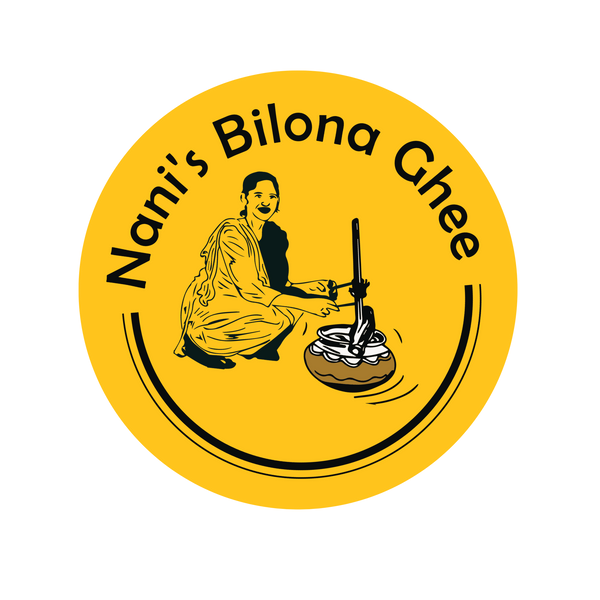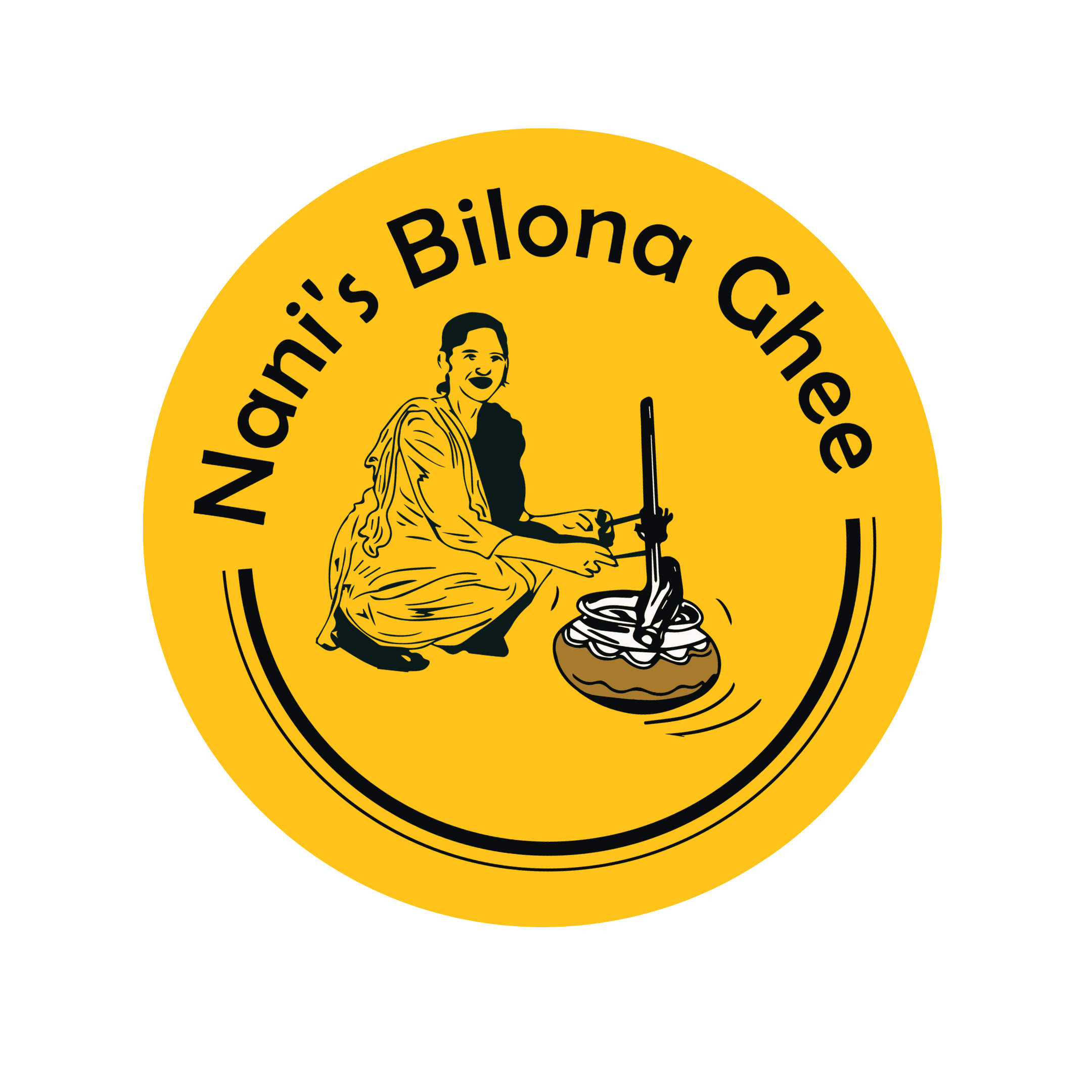
How to Identify Pure Bilona Ghee?
Share
Ghee Is Everywhere - But Purity Is Rare
Walk into any supermarket or scroll through Instagram, and you’ll see dozens of “pure ghee” brands.
But the truth is, not all ghee is created equal.
In fact, many so-called pure ghees are:
-
Made from cream, not curd
-
Processed at high heat
-
Mixed with oils, starch, or vanaspati
-
Packaged beautifully, but hiding shortcuts
So, how do you identify the real deal - authentic, pure Bilona Ghee that actually nourishes your body like it should?
Let’s walk you through it, step by step — Nani-style.
1️⃣ Check the Milk Source: A2 Desi Cow or Nothing
Real Bilona Ghee starts with A2 cow milk from Indian breeds like Gir, Sahiwal, or Tharparkar.
These cows produce milk with A2 beta-casein protein, which is easier to digest, less inflammatory, and traditionally used in Ayurveda.
If the label says:
-
"Mixed milk"
-
"Cream-based"
-
Or doesn’t mention the breed
That’s your first red flag.
✅ Look for: “A2 Desi Cow Milk” clearly mentioned.
2️⃣ Look for the Word “Bilona” and What It Actually Means
Bilona is not a marketing word, it’s a traditional, multi-step ghee-making process that takes 3–4 days per batch.
Here’s how it works:
-
A2 cow milk is boiled
-
Turned into curd using natural culture
-
Curd is hand-churned to extract makkhan (butter)
-
Butter is slow-cooked over low flame to make ghee
This retains:
-
Butyric acid
-
Conjugated Linoleic Acid (CLA)
-
Fat-soluble vitamins (A, D, E, K)
-
The natural flavor and aroma of authentic ghee
❌ Most commercial ghees are cream-separated, high-heat processed, and lose 70% of their nutrients.
3️⃣ Check the Color, Texture & Aroma
Your senses can guide you.
|
Sign |
Pure Bilona Ghee |
Adulterated/Commercial Ghee |
|
Color |
Golden yellow |
Pale white or neon yellow |
|
Texture |
Slightly grainy, melts quickly |
Waxy or overly smooth |
|
Aroma |
Nutty, fresh, sweet |
Flat or overly strong |
✅ Pro Tip: In winters, real ghee semi-solidifies with grainy crystals. That’s a great sign!
4️⃣ See If It's Made from Curd, Not Cream
Most commercial brands skip fermentation.
They separate cream from milk and cook it directly, a faster but inferior method that:
-
Removes probiotic benefits
-
Strips digestive value
-
Increases heaviness and acidity
Bilona ghee = curd-based = superior in digestion, Ayurveda, and taste.
Check the label, ask the brand, or visit their website. If it doesn’t say “curd-based,” it probably isn’t.
5️⃣ Transparency Matters: Is It Lab-Tested?
In today’s market, where synthetic ghee, flavored oils, and vanaspati blends are common, you need assurance.
Look for brands that provide:
-
Lab test reports
-
Ingredient traceability
-
Certifications (FSSAI, non-GMO, organic)
✅ Nani’s Bilona Ghee is tested in NABL-accredited labs, and every batch is traceable to its desi cow milk source.
6️⃣ Evaluate Shelf Life & Price
Authentic ghee:
-
Has a natural shelf life of 9–12 months
-
Costs more than commercial ghee due to the slow process and A2 milk
If you see a 1L jar for ₹300–₹400 claiming “hand-churned A2 ghee” that’s not sustainable math.
If it sounds too good to be true, it probably is.
🧪 DIY Test (At Home)
Still not sure? Try these old-school tests:
|
Test |
How to Do It |
What It Means |
|
Palm Test |
Rub a small amount of ghee in your palm |
Pure ghee melts quickly due to body heat |
|
Fridge Test |
Refrigerate overnight |
Pure ghee solidifies uniformly |
|
Burn Test |
Heat ghee in a spoon |
Pure ghee burns cleanly with a steady flame, no residue |
🧘 Why Bilona Ghee Is Worth It
|
Value |
Commercial Ghee |
Bilona Ghee |
|
Process |
Machine-separated cream |
Curd + hand-churned |
|
Time to Make |
Few hours |
3–4 days |
|
Digestibility |
Heavier |
Easily digestible |
|
Ayurvedic Use |
Rare |
Daily ritual |
|
Price |
₹400–₹600/litre |
₹1,200–₹1,800/litre |
|
Nutrient Retention |
Low |
High (butyric acid, CLA) |
🛍️ Final Checklist Before You Buy
Before buying ghee (online or offline), run this quick checklist:
-
Does it mention A2 Desi Cow Milk?
-
Does it say curd-based or Bilona process?
-
Is the texture grainy, golden, and fragrant?
-
Is it lab-tested or certified?
-
Is it priced fairly for the process?
-
Is the brand transparent about sourcing?
If you answered “yes” to all, you’ve found a winner.
💬 Final Thought: Ghee is an Investment, Not a Commodity
When you buy ghee, you’re not just buying fat.
You’re buying:
-
Digestive health
-
Mental clarity
-
Immunity
-
Skin glow
-
And 5,000+ years of Ayurvedic tradition
Choose wisely. Choose slowly. Choose Bilona.
🛍️ Ready to Try the Real Thing?
→ Nani’s A2 Bilona Ghee – From Curd. Not Cream. Made the Right Way.
❓Frequently Asked Questions (FAQs)
Q1: What does “Bilona” actually mean?
A: It’s a traditional 4-step ghee-making process: milk → curd → hand-churned butter → slow-cooked ghee. No shortcuts, no additives.
Q2: How can I check if ghee is fake?
A: Do the palm test, fridge test, or burn test. And always verify labels for milk source, lab testing, and process.
Q3: Why is Bilona Ghee more expensive?
A: It takes 25–30L of A2 milk, 3–4 days, and manual effort to make 1L of ghee. The price reflects purity and tradition.
Q4: Is grainy ghee good or bad?
A: Very good! Graininess indicates slow cooking and purity. It's a signature of traditional ghee.
Q5: Can I use Bilona Ghee daily?
A: Absolutely. It’s lighter, sattvic, and ideal for cooking, skincare, detox, or rituals.

